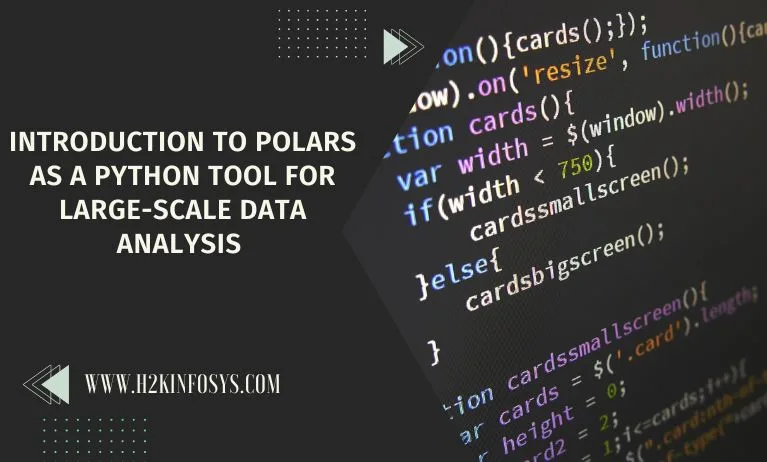Python is a widely used language in the field of data analysis because of its adaptability and vast ecosystem of libraries. To gain insights and make wise judgments, data manipulation, and analysis are essential. Python Tool for Large-Scale Data Analysis But as datasets continue to expand in size and complexity, it becomes more and more important to use high-performance solutions.
Tools that can perform quick computations and streamlined operations are necessary for effectively managing massive datasets. Polars enter the picture in this situation. Polars is a potent open-source module created exclusively for Python’s high-performance data analysis and manipulation. To learn more about Polars check out the Python course online.
Features of Polars
An alternative to the well-known pandas library, Polars is a DataFrame library that was entirely written in the Rust programming language. It was created to provide Python writers with a scalable and effective framework for processing data. It offers a wide range of features that make it easier to perform different data processing and analysis activities. The following are some of the main benefits and aspects of using Polars:
1.Performance and Speed
Performance is the main focus of Polars’ engineering. It uses parallel processing and memory optimization techniques to process huge datasets much more quickly than conventional approaches.
2.Data manipulation capabilities
Polars provides a comprehensive toolkit for data manipulation, encompassing essential operations such as filtering, sorting, grouping, joining, and aggregating data. While Polars may not have the same extensive functionality as pandas due to their relative novelty, it covers approximately 80% of the common operations found in Pandas.
3.Expressive syntax
Polars has a clear and simple syntax that is simple to learn and use. Due to its syntax’s resemblance to well-known Python libraries like pandas, users can quickly become used to Polars and make use of their current knowledge.
4.Series and DataFrame structures
The DataFrame and Series structures, which offer a dependable and effective abstraction for working with tabular data, are at the heart of Polars. Polars’ ability to chain together DataFrame operations makes it possible to change data in an effective and condensed manner.
4.Polars support lazy evaluation
Lazy evaluation, a feature of Polars, includes analysing and refining queries to improve performance and reduce memory usage. When using Polars, the library examines your queries and looks for ways to speed up their processing or use less memory. Pandas, in contrast, only enables eager evaluation, in which case expressions are immediately evaluated when they are encountered.
When we have pandas, why choose Polar?
The widely used library pandas are renowned for its adaptability and simplicity. However, due to its dependency on single-threaded processing, Pandas might have speed bottlenecks when working with huge datasets. Processing times may get unreasonably long as the dataset size grows, reducing productivity.
Large dataset handling has been carefully incorporated into the architecture of Polars. Polars is particularly good at processing large volumes of data quickly because of its lazy evaluation method and parallel execution features. Polars makes use of parallelism by dividing computations among several CPU cores to produce significant speed benefits.
Interoperability and Integration
Data analysts can take advantage of a variety of tools and functions thanks to Polars’ smooth interface with other well-known Python libraries. Let’s look at two crucial integration components: compatibility with other libraries and interoperability with Pandas.
Integrating Polars with other Python libraries
Users may easily combine the benefits of several technologies in their data analysis processes thanks to Polars’ straightforward integration with libraries like NumPy and PyArrow. Polars seamlessly converts between Polars DataFrames and NumPy arrays thanks to the NumPy integration, taking advantage of NumPy’s robust scientific computing capabilities. Analysts may now simply apply NumPy functions to Polars data thanks to this connection, which also guarantees seamless data migrations.
Similar to this, Polars streamlines data transfer between Polars and Arrow-based systems by using PyArrow. This integration makes it easy to deal with data saved in the Arrow format and makes use of Polars’ powerful data manipulation tools.
Conclusion
Python’s Polars package is a potent tool for high-performance data manipulation and analysis. It is the best option for effectively managing massive datasets due to its speed and performance enhancements.
Polars provides a comfortable and understandable interface for activities involving data processing thanks to its expressive syntax and DataFrame structures. Additionally, Polars smoothly interfaces with other Python libraries like NumPy and PyArrow to increase its functionality and give users access to a wide range of tools.
Polars DataFrames can be converted to Pandas Polars can be easily incorporated into current workflows thanks to DataFrames’ guarantee of interoperability. Polars offers a complete toolkit to help you realise the full potential of your data analysis projects, whether you’re working with complex data types, managing enormous datasets, or looking for efficiency enhancements.
A good Python training online will explain how Pandas is a vital Python tool especially in Data analysis.






























